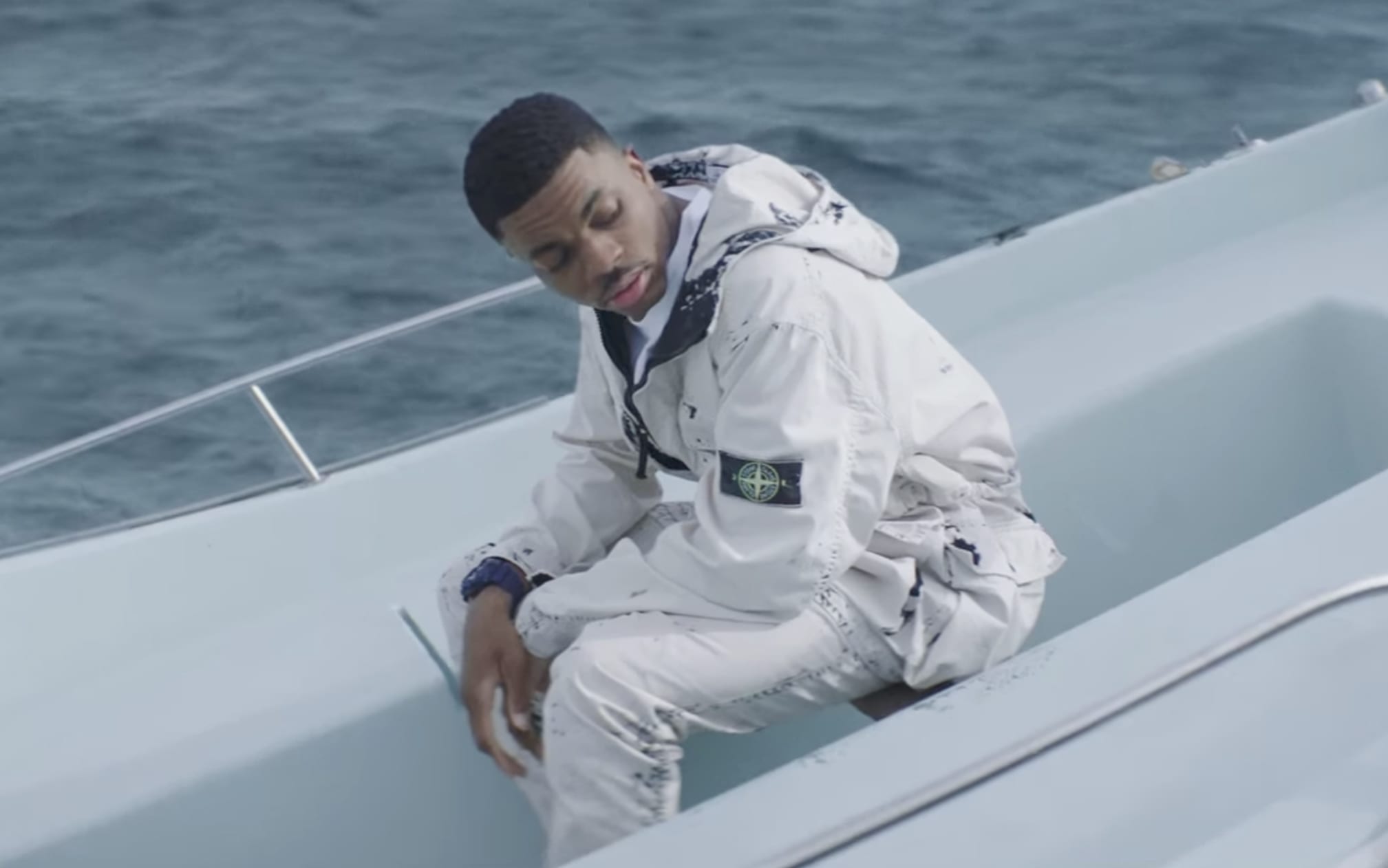
Vince Staples opens his second full-length album for Def Jam with a pair of songs, “Crabs In A Bucket” and “Big Fish,” that both invoke popular marine life metaphors for human nature. But it raises the question: who is Vince Staples right now? Is he a big fish in a small pond, the most prominent young rapper from Long Beach (outside of maybe O.T. Genasis)? Or is he a small fish in a big pond, a critically acclaimed but low-selling artist on a major label roster?
About a minute into “Crabs In A Bucket,” Vince Staples declares “give me some drums to go pop with, need white women at the shows” over a propulsive UK garage beat. It’s a characteristically witty, self-deprecating moment, but it’s possible to hear it as a statement of intent in the context of the sound of Big Fish Theory.
In the past year, Staples has begun to branch out beyond hip-hop, guesting on albums by Flume and Gorillaz, while still maintaining a hip-hop audience. But since the album’s release on Friday, the more danceable drums and twitchy, glitchy textures of Big Fish Theory have been debated as, perhaps, Vince’s choice to chase EDM festival crowds. Big Fish Theory has already been compared to divisive albums like Common’s Electric Circus and Kanye West’s Yeezus which served up a sonic curveball to a popular MC’s fan base.
Vince Staples came up in the orbit of Odd Future, but he’s always seemed to be on a different trajectory than Tyler, The Creator, more engaged with contemporary hip-hop and less content to foster a cult following.
But Vince Staples is not remotely as well-established as those artists were at the time. This is his second full-length album, and the first one, 2015’s Summertime ’06, didn’t establish any significant mainstream presence. He’s an artist on the rise, but more because of rave reviews than its negligible sales and radio spins. Vince Staples came up in the orbit of Odd Future, but he’s always seemed to be on a different trajectory than Tyler, The Creator, more engaged with contemporary hip-hop and less content to foster a cult following. The first time I heard Vince Staples was when he was featured on Earl Sweatshirt’s 2013 single “Hive” alongside Casey Veggies, and it just seemed like southern California was overrun with rappers who had mundane first names paired with seemingly random nouns as last names.
As it turns out, Staples is actually Vince’s birth name, which cannot be said of Mr. Sweatshirt or Mr. Veggies. And that’s kind of Vince Staples in a nutshell: even the things about him and his music that can seem a little contrived or improbable are delivered with a matter-of-fact shrug that makes more sense if you take him at face value. The first three projects Vince Staples released on Def Jam, Summertime ’06 and two EPs, were driven by booming, minimalist production by No I.D. and DJ Dahi. Staples, always a plainspoken and conversational rapper, has gradually increased the nasal twang in his delivery since his early records. But it felt almost like part of his command of West Coast rap tropes, a B-Real voice to go with his most harrowing stories.
Those records were like gourmet gangsta rap, but instead of continuing to cultivate that sound, Staples has swapped it out for an almost entirely different production team on Big Fish Theory, including Zack Sekoff, GTA, Christian Rich, and Bon Iver’s Justin Vernon.

The more electronic sound of Big Fish Theory may feel like a marked change in direction, but it also feels like Staples is trying to bring together different worlds in a deliberate way. Samuel “SOPHIE” Long, a producer associated with the London-based electronic label PC Music that’s known for trebly, subversive takes on dance pop, produces two tracks. And it doesn’t seem like an accident that those tracks feature the album’s most famous guest rappers, Kendrick Lamar and A$AP Rocky. Damon Albarn sings and plays keyboards on “Love Can Be…” and Staples quotes Jeezy’s verse from the “Hood N***a” remix on the same track, which seems like an elaborate set up for a Gorillaz/Gorilla Zoe joke that Staples never gets around to making.
The last time we heard from Vince Staples was last summer’s Prima Donna EP, a mini concept album about a suicidal rap star, which he’s said was inspired partly by the Amy Winehouse documentary Amy. Big Fish Theory picks that thread back up on “Alyssa Interlude,” which samples a Winehouse interview featured in the film where she declares, “I’m quite a self- destructive person.” A few tracks later on “Homage,” Staples gets into a rare braggadocious mood, but once again ends up at the intersection of fame, youth, and tragedy: “Please do not treat me like I’m not a genius / I’m runnin’ on empty, the new River Phoenix.”
that’s kind of Vince Staples in a nutshell: even the things about him and his music that can seem a little contrived or improbable are delivered with a matter-of-fact shrug that makes more sense if you take him at face value.
Vince Staples is an unusually world weary 23-year-old. He’s younger than 21 Savage but dresses more like a middle-aged dad than a lot of rappers twice his age. And aside from flirting with Odd Future-style shock rap on Earl Sweatshirt’s “epaR” at the age of 16, Staples has been remarkably self-assured and consistent in his musical and lyrical choices. The irreverent wit he freely displays in tweets and interviews is usually reined in on his albums in favor of more carefully constructed wordplay and storytelling.
Whether the offbeat sound of Big Fish Theory is a way of avoiding the kind of major fame he associates with dying young, or simply an artist chasing his muse, it’s a fascinating twist in the road for a rapper who seems to avoid following anyone else’s career path.
